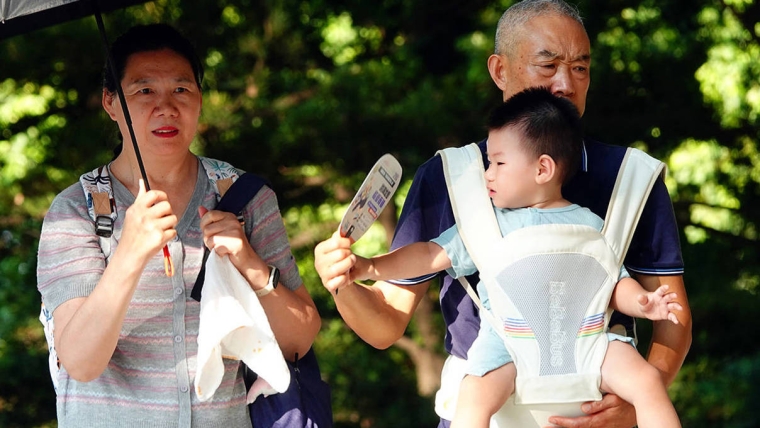
News stories about China nowadays largely focus on geopolitical developments, particularly the Sino-American rivalry. But China’s 1.4 billion people, while aware of these issues, are more preoccupied with a problem that hits much closer to home: their shrinking families.
For millennia, Confucian values have defined the family as essential to social order and harmony, with family relations playing a central role in confronting challenges such as competition for land and resources. Sons managed farms and businesses, and cared for elderly parents. Daughters expanded the family through marriage, creating large extended networks that carried out critical economic and social functions, such as building schools and resolving disputes – functions that in Europe might have been carried out by the church.
This basic economic and social structure survived even the dislocations of the 1950s-70s, when the new Communist regime encouraged people to live in dormitories (away from their families, including their spouses) and to send their children to state-run nurseries and boarding schools in order to boost labor productivity.
Today, however, the Chinese family is in crisis, owing to plummeting fertility rates, which declined from 7.51 children per woman in 1963 (its modern peak) to just one per woman in 2023. This demographic collapse is putting China’s economy, society, and polity at risk.
The roots of China’s fertility struggles are deep. China’s population more than doubled between 1900 and 1979, from 400 million to 969 million. Food shortages were so common during this period that China became known as the “land of famine.” Between 1959 and 1961, China endured the worst famine in recorded history, with 20-45 million people dying as a result of both high population density and deeply flawed government policies. So, beginning in the 1970s, China’s government introduced strict family-planning laws that, for decades, restricted most Chinese households to one child.
But family-planning laws are only part of the story. Though China’s now infamous one-child policy was loosened in 2016, to two children, and then in 2021 to three, fertility rates have not increased.
And unlike other countries grappling with low fertility rates, such as Japan and South Korea, China is still a poor country. According to the most recent data (from 2022) China’s median per capita disposable income is US$6,224 ($17 per day) for the 944 million people living in urban areas, and just US$2,777 ($7.61 per day) for the 465 million in rural areas. In the United States, that figure is US$63,589. Even accounting for America’s higher prices, the difference is huge. Add to that limited economic opportunities for young people – including those with university degrees – and Chinese households simply cannot afford more children.
The newest generation of Chinese parents face an additional psychological hurdle, rooted in their lack of firsthand experience of big families. The vast majority of them grew up as only children in households with two only children as parents, as well as four grandparents. They did not have cousins or siblings to play with, but they did have a large number of adult caregivers. As a result, many do not value large families and find the notion overwhelming.
But all those caregivers imply heavy dependencies as generations age. A small and shrinking cohort of working-age Chinese, operating in a job market characterised by sparse opportunities and low wages, is now supporting a larger and growing population of retired individuals, who have limited access to pensions and health care. And their responsibilities extend beyond finances to include physical and emotional support.
As if that were not enough, each young person is also the only source of pride for their parents and grandparents, who have collectively dedicated their lives – their time, energy, and money – to setting the child up for success. Young adults now have to earn all the sacrifices their caregivers made for them, effectively compensating their parents and grandparents for the children and grandchildren who were never born.
This burden of responsibility is felt starting in childhood. Playgrounds are largely empty, and parks are populated mostly by retirees, even after school and on weekends. Children are more likely to be at home studying than outside playing. All this pressure may well be fueling rising rates of depression and suicide among youths and young adults.
The situation is set to worsen. Slower economic growth – which has already driven youth unemployment to historic highs – will continue to constrain the job market, intensifying already-fierce competition for limited opportunities, and will impede the government’s ability to increase pensions.
China’s government has a strong interest in addressing the crisis of the country’s families. Economic and social problems tend to evolve in unpredictable ways, and they can easily spiral into political instability. Although the government has implemented a broad range of policies aimed at encouraging families to have children, including monetary incentives, fertility remains low.
How will a civilisation built around family units and networks fare as a nation of individuals without siblings and cousins? What will the lives of the elderly be like when there are few young adults to care for them? Can ordinary Chinese, to whom family represents both a virtue and a way of life, feel content without children? As the specter of social and economic upheaval looms, these questions must be answered.
Nancy Qian, Professor of Economics at Northwestern University, is Co-Director of Northwestern University’s Global Poverty Research Lab, Founding Director of China Econ Lab, and a visiting professor at the Einaudi Institute for Economics and Finance. Copyright: Project Syndicate, 2025, published here with permission.
9 Comments
Good article... buuuuut...
Most of China is no longer poor. Claiming they are poor by taking their USD equivalents isn't they way to prove they are poor, when they essentially peg their dollar to the US, but at a very low rate, to be competitive. I would argue that the RMB is worth probably 1.5-2 USD, not the 6-8 that they hover it at.
A simple meal out in the US now costs $12-15 (that's for like Subway or McD's). If you want anything not fast food, you are easily paying $25. And all of that is probably using some form of cheap immigrant/illegal worker.
In China, a bowl of noodles at your local might cost you 20-25 RMB on the East Coast. There is no way you are getting a feed in the US for $3-4, the USD equivalent. This applies to almost everything in China EXCEPT housing, which is still quite expensive in the East Coast cities. Hence why I say 1.5-2x is the right ratio, if the RMB was allowed to float.
That would put the median Chinese disposable income at somewhere like $20k USD, quite middle class when taking into account the lower costs. I would suggest that a greater percentage of people in China now experience a better quality of life than those in the US. Particularly with wealth imbalances in the US skyrocketing. Healthcare in China is actually affordable, for instance, even if it might not quite be at the same standard in the US.
There's almost twice as many Chinese or Japanese living below their own defined poverty lines than in the US.
A sad situation. IMO the root of this is explained by 'This basic economic and social structure survived even the dislocations of the 1950s-70s, when the new Communist regime encouraged people to live in dormitories (away from their families, including their spouses) and to send their children to state-run nurseries and boarding schools in order to boost labor productivity.' A basic connection for family was broken. 'This basic economic and social structure survived' No it didn't which is the subject of the article. At first glance the 'state-run nurseries and boarding schools' made their children dysfunctional.
There's something inherent to East Asian culture that depresses their birth rates to a greater extent than most other regions.
Speed of economic advance?
Level of urbanization?
High rise apartment living is anti natal.
https://x.com/MoreBirths/status/1951233693978112459/photo/2
And yet
Living crammed up in a slum isnt
As poverty has plummeted so have birth rates.
https://ourworldindata.org/grapher/fertility-rate-vs-the-share-living-i…
https://bbc.com/news/articles/c74dnzr4jdvo
Happening in Japan as well. 2 deaths for every 1 birth.
Kids are going to be the new oil and immigrants are going to be fought over by many suitors
I also query the continued designation of China as poor. More likely an issue of distribution with huge wealth kept by the few and no social/ government support for most. China keeping itself as a developing nation accords it all sorts of benefits not least its ( and India’s) preferential status under the Paris climate rules of being able to not just keep polluting but actively increase its carbon output. The other irony of course, and this applies to all countries, is that the poor little planet needs less not more people.

We welcome your comments below. If you are not already registered, please register to comment.
Remember we welcome robust, respectful and insightful debate. We don't welcome abusive or defamatory comments and will de-register those repeatedly making such comments. Our current comment policy is here.